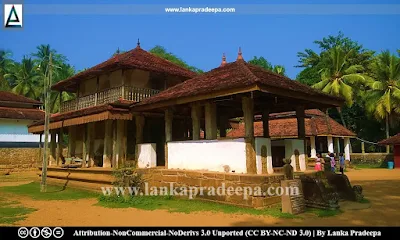
The Ruins of the Ancient City of Dambadeniya are found scattered in and around the Dambadeniya Maliga Gala area in Kurunegala District, Sri Lanka.
History
Polonnaruwa Kingdom
(1056-1236 A.D.), the second kingdom of Sri Lanka was abandoned in the
13th century mainly due to its susceptibility to invasions from South
India. Also, the struggles to grab the power of the throne among the
rulers who came after King Nissankamalla (1187-1196 A.D.) had already
put the country's political environment into an unstable
state (Dias et al., 2016). Magha (1215–1236 A.D.) of Kalinga (India) who
came with a large
army from Malabar (Kerala) easily invaded Sri Lanka during this period
and as a result of that, Polonnaruwa collapsed and Dambadeniya
became the new and the third kingdom of the country (Dias et al., 2016;
Sudharmawathie, 2008).King Vijayabahu III (1232-1236 A.D.) was the first king who chose Dambadeniya as the new capital.
Monuments
Dambadeniya Maliga Gala Palace ruins Maliga Gala Mountain (or Jambudoni Mountain) is considered the site where the royal palace of Dambadeniya erected by King Vijayabahu III was located. According to chronicles such as Culavamsa, the king built a new
city on the summit of the Jambudoni mountain consisting of fine walls and
gate towers (de Silva, 1990). The details given in the Dambadeni Asna
reveal that there were two parts of the capital: the inner city and the
outer city (de Silva, 1990). The inner city where the main buildings of
the kingdom were located such as the Palace Complex and the Temple of the Tooth is said to be protected with an 18-cubit tall wall (de Silva,
1990). The outer city had three boundary walls built of stone, clay, and
timber (de Silva, 1990). The remains of the clay (earth) wall are still
visible at the site.
The ruins of the palace building are seen on the western part of the Maliga Gala rock summit (Anuradha & Kumari, 2015). It has been identified as a building with an inner compound and the remains of old channels that had been used to remove the accumulating rainwater in the compound are still visible (Anuradha & Kumari, 2015).
Three ponds named Ura Pokuna, Mavee Pokuna and Ratmal Pokuna are found on the summit of the rock.
King Vijayabahu III (1232-1236 A.D.) built Vijayasundararama Viharaya as the main temple
of the kingdom and started an academy similar to Maha Viharaya and Abhayagiriya in Anuradhapura. The next ruler, King Parakramabahu II (1236-1270 A.D.) constructed
two temples for the sacred Tooth Relic of the Buddha on the summit of
the Maliga Gala and on the premises of Vijayasundararama temple. The
temple built at the Maliga Gala was the permanent house for the Tooth
Relic and the other at Vijayasundararamaya was used mainly for the relic
expositions (Seneviratna, 1987).
Waduwa Ketu Gala
The mountain known as Waduwa Ketu Gala (or Mapa Gedara Gala) is said to be the site where the abodes of the people of Adhikarana Senevirath Mapa were located (Anuradha & Kumari, 2015). According to another view, this site has been used during the Dambadeniya period to detain prisoners. Ruins of some buildings, ponds, and a rock-cut flight of steps can be seen scattered over the mountain.
Ancient tank
Part of an old bund of a breached tank has been found on a site located between the Maliga Gala and Mapa Gedara Gala mountains (Anuradha & Kumari, 2015). This tank is believed to have been used by King Parakramabahu II for his war and defence activities (Anuradha & Kumari, 2015).

 .
.See also
References
1) Anuradha, R.K.S.; Kumari, A.S., 2015. Pauranika Sthana Saha Smaraka: Kurunegala Distrikkaya (In Sinhala). Department of Archaeology (Sri Lanka). ISBN: 955-9159-37-2. pp.22-23,27-29.
2) de Silva, N., 1990. Sri Lankan architecture during the period 1200-1500 A.D. Wijesekara, N. (Editor in chief). Archaeological Department centenary
(1890-1990): Commemorative series: Volume III: Architecture. Department
of Archaeology (Sri Lanka). pp.76-77.
3) Dias, M.;
Koralage, S.B.; Asanga, K., 2016. The archaeological heritage of Jaffna
peninsula. Department of Archaeology. Colombo. p.178.
4) Seneviratna, A., 1987. The Temple
of the Sacred Tooth Relic: An Architectural History of the Daḷadā
Māligāwa, the Symbol of Buddhist Faith and Sovereignty in Sri Lanka. Government of Sri Lanka. p.59.
5) Sudharmawathie,
J.M., 2008. Historical significance of the kingdom of Dambadeniya,
Proceedings of the Annual Research Symposium 2008, Faculty of Graduate
Studies, University of Kelaniya. p.105.
Location Map
This page was last updated on 14 May 2023



